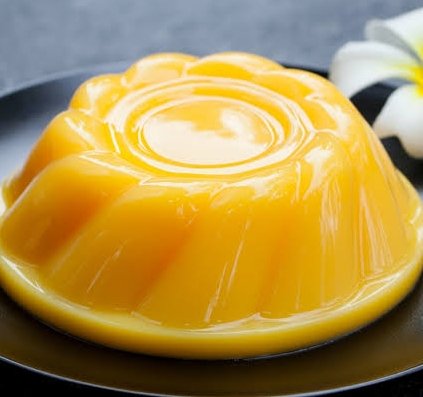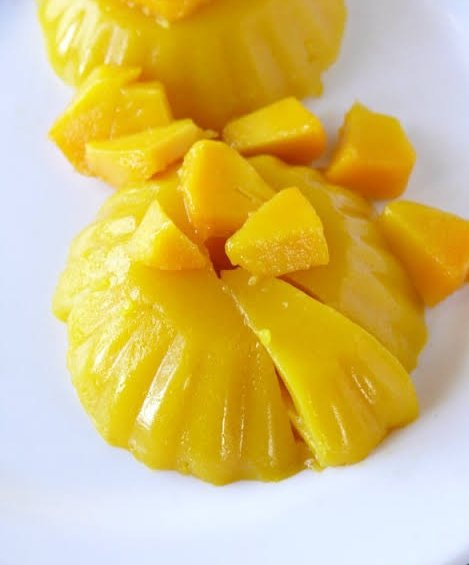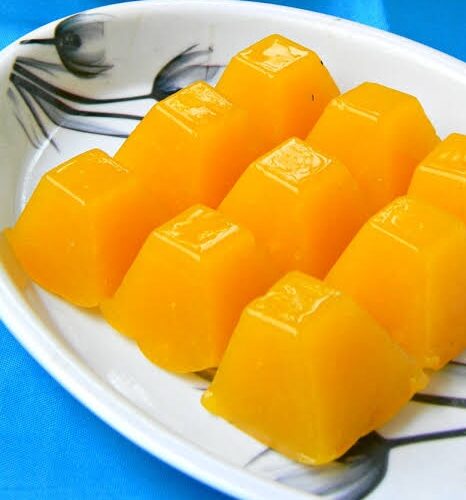Mango pulp, gelatin, sugar, and water are combined to create the sweet, delicious delicacy known as mango jelly. Mango pulp is combined with sugar, water, and gelatin before being boiled and combined with the gelatin until the mixture thickens and takes on the form of jelly. It can be topped with whipped cream or fresh fruit and is typically served chilled.
Many nations, especially those where mangoes are commonly accessible, enjoy mango jelly as a dessert. It is frequently served during special occasions and festivals and may be found there as well as in Southeast Asia, India, and Latin America. Additionally, mango jelly can be added as a garnish on cakes, yogurt, or ice cream.
People of all ages appreciate the tasty and refreshing dessert known as mango jelly. It’s a wonderful way to experience mangoes’ sweet and sour flavor in a novel and enjoyable way. Mango jelly is a healthy dessert option when consumed in moderation because mangoes are a wonderful source of vitamins and antioxidants.
Depending on the recipe and the consumer’s preferences, there are numerous ways to make mango jelly. In order to improve the flavor and texture of the jelly, several recipes ask for the addition of other fruits like strawberries or kiwis. Condensed milk or coconut milk may be used in other ways to give the jelly a rich, creamy texture.
This jelly is not only a delectable dessert, but it’s also simple to make and only needs a few basic ingredients. For the finest flavor and consistency, you should use ripe, fresh mangoes. To avoid lumps or inconsistent texture in the jelly, the gelatin used in the recipe needs to be completely dissolved in hot water and thoroughly combined with the mango pulp.
This jelly can also be customized to suit different dietary needs and preferences. For example, vegetarian and vegan versions of mango jelly can be made using agar agar instead of gelatin, and sugar can be substituted with natural sweeteners such as honey or maple syrup. Additionally, mango jelly can be made gluten-free by using a gluten-free version of gelatin or agar agar.
Mango jelly is an all-around tasty and adaptable treat that may be consumed on its own or as a garnish for other sweets. It is a wonderful method to appreciate mango flavor and is ideal for hot weather when a light dessert is sought.
Ingredients:
- Ripe mangoes: Mangoes that are ripe and delicious are necessary to make mango jelly. Mango pulp can be used either fresh or canned, depending on availability and preference. You will need approximately 2 medium-sized mangoes to make 1 cup of mango pulp.
- Gelatin or agar agar: To set the jelly and give it a hard texture, gelatin or agar agar is employed. Agar agar, which is made from seaweed and has a similar setting property, can be used if you are vegetarian or vegan.
- Sugar: To increase the sweetness of the jelly, sugar is added to the mango pulp. Depending on your personal preferences and how sweet you want your mangoes, you can modify the sugar amount.
- Water: To guarantee that the mango jelly sets properly, water is added to the mixture in order to dissolve the gelatin.
- Ingredients that are optional: You can enhance the mango jelly’s flavor and texture by including things like coconut milk, lemon juice, or chunks of fresh fruit.
Instructions:
- Mangoes should be peeled and cut into small pieces. Take the seed’s flesh off.
- In a blender or food processor, puree the mango chunks until they are smooth. If you want the mangoes to combine more easily, you can add a little water.
- Mango puree should be heated in a saucepan over low heat. Stir in the sugar until it completely melts.
- To completely dissolve the gelatin powder, combine it with a little water in another bowl.
- Stir carefully to incorporate the dissolved gelatin after adding it to the mango puree mixture.
- Place the mango mixture in a mold or serving dish that has been lightly greased. At this point, if you’d like, you can also incorporate fruit pieces, like thinly sliced strawberries or kiwis.
- After allowing the mixture to come to room temperature, put it in the refrigerator for at least two to three hours, or until the jelly has set and hardened.
- Once the jelly has hardened, use a knife to release the mold’s edges. To release the jelly, invert the mold onto a plate or serving dish and give it a little tap.
- Serve cold mango jelly that has been cut into cubes or other preferred forms.

Notes:
- Note that the quantities of these ingredients may vary depending on the recipe and serving size of the mango jelly. It is important to follow the recipe instructions carefully to ensure that the jelly sets properly and has a good flavor.
- You should carefully study the recipe before you start because the directions may change depending on the recipe you’re using. Additionally, the directions might be a little different if you’re using agar agar rather than gelatin.
Serving suggestions:
- Dessert: Mango jelly is a light and energizing dessert that tastes well on its own or when combined with fresh fruits like berries or mango slices.
- With ice cream: For a tropical twist, top a scoop of vanilla or coconut ice cream with a spoonful of mango jelly.
- For an extra boost of mango flavor and texture in smoothies, stir in a spoonful of mango jelly.
- For a tasty and nutritious breakfast or snack, stir some mango jelly into a cup of Greek yogurt.
- On toast: For a delicious and fruity breakfast, spread some mango jelly on toast or croissants.
- Cocktails: To give your favorite drink a touch of the tropics, stir in a spoonful of mango jelly. Mango jelly complements rum, tequila, or vodka-based beverages extremely nicely.
- As a garnish: To give a fruity and energizing touch to cheesecakes, pavlovas, or other desserts, drizzle mango jelly on top.
Tips and variation:
Tips:
- For the finest flavor and texture, use ripe, fresh mangoes.
- Before adding it to the mango puree, make sure the gelatin or agar agar is completely dissolved in hot water.
- For it to become hard and simple to cut, let the mango jelly set in the refrigerator for at least two to three hours.
- To give your mango jelly a distinctive shape and pattern, use several molds or presentation dishes.
- Mango jelly pairs well with whipped cream, ice cream, or fresh fruit for added flavor and texture.
Variation:
- Coconut milk or condensed milk can be used in place of water to create a creamy jelly.
- A tablespoon of lemon juice can be added to the mango puree combination to give it a tart flavor.
- To the mango puree combination, you can add chopped fresh fruit pieces for flavor and texture, like strawberries or kiwis.
- Use agar agar in place of gelatin to create a vegan version of jelly.
- Use honey or maple syrup in place of sugar for a healthy alternative, and use fresh fruit pieces as a garnish rather than whipped cream or ice cream.
- To the mango puree combination, you can also add a dash of cinnamon or cardamom powder for flavor.
FAQs:
Q: How long does mango jelly last in the refrigerator?
Ans: If kept in an airtight container, this jelly can keep for up to 5-7 days in the refrigerator.
Q: Can I make mango jelly without using a blender or food processor?
Ans: Yes, you can mash the mangoes by hand rather than using a food processor or mixer. Even if the texture might not be as smooth, it still functions.
Q: Can I use canned mango pulp for making mango jelly?
Ans: In the event that fresh mangoes are unavailable, you can substitute canned mango pulp. Use top-quality mango pulp, though, free of any artificial flavors or preservatives.
Q: Can I use agar agar instead of gelatin for making mango jelly?
Ans: Agar agar can be used as a vegetarian substitute for gelatin, that much is true. It’s crucial to stick to a recipe that employs agar agar because the quantities and directions for utilizing it may differ from those for gelatin.
Q: Can I make mango jelly without sugar?
Ans: Yes, you may replace sugar with natural sweeteners like honey, maple syrup, or agave nectar. But bear in mind that the sweetness of the mangoes will also impact how sweet the jelly is all around.
Q: How do I fix mango jelly that hasn’t been set properly?
Ans: You can try boiling the jelly again on low heat and adding a little extra gelatin or agar agar if it hasn’t been set properly. As an alternative, you can use it in place of jelly as a sauce or topping.
Q: Can I use other fruits instead of mangoes to make jelly?
Ans: Yes, you can make jelly with various fruits including peaches, strawberries, and raspberries. Depending on the fruit you use, the procedure and the components may change.
Nutrition:
| Calories | 110kcal |
| Carbohydrates | 27gm |
| proteins | 2g |
| sodium | 25mg |
| Potassium | 35g |
| sugar | 25g |
| Vitamin A | 2% |
| Vitamin C | 10% |
| Calcium | 5mg |
| Iron | 0mg |
A serving of it produced with sugar and gelatin is equal to 1/2 cup (100g) of the following nutritional information:


